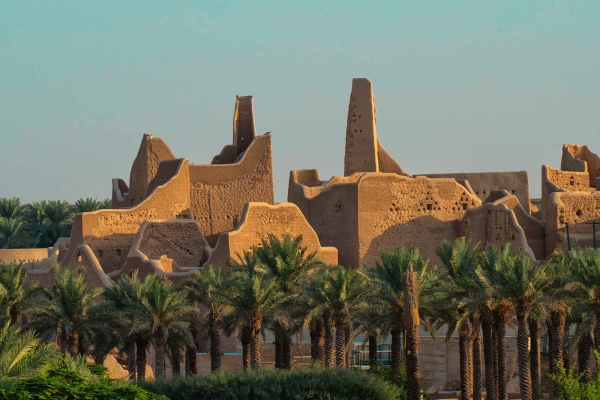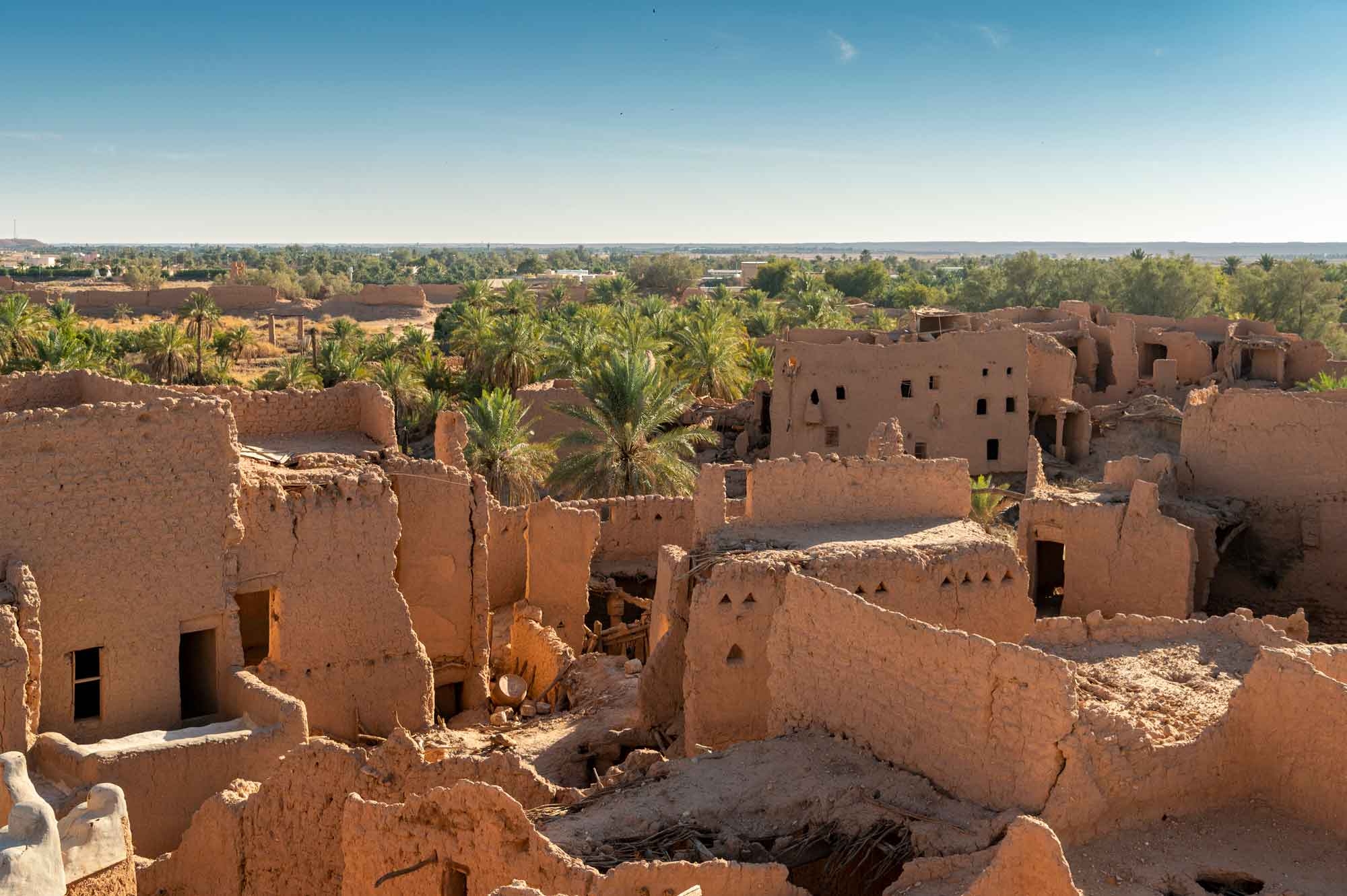






Antiquities in Riyadh Province are the tangible remains and legacies of ancient human civilizations located in Riyadh Province in the central part of the Kingdom of Saudi Arabia. The oldest of these traces back to the Paleolithic period.
Antiquities of Riyadh Province in the Paleolithic Period
Human groups settled in Riyadh Province over extended periods due to the province's diverse topography and favorable climatic conditions during prehistoric times. Archaeological studies in the area have revealed multiple settlement patterns, indicating habitation in mountainous areas, low mountain ranges, plains, valleys, and water bodies. The chronological stages of the Stone Age have been divided into several phases, representing the evolution in the production of stone tools, as follows:
- Early Paleolithic Period: This period includes two main cultures: the Oldowan and Acheulean Cultures. Riyadh Province is particularly rich in Acheulean artifacts. Significant Acheulean sites have been found north of Riyadh City near King Khalid International Airport, in Uruq Binban area, and on al-Arma plateau. Tuwaiq Mountains, with their mountainous and plain areas within the Arabian Shield area, also contain dozens of Acheulean archaeological sites. One notable site is Safaqah in ad-Dawadimi Governorate, estimated to be around 230,000 years old. Artifacts discovered at these sites include stone axes, trihedral tools, raw stones, cleavers, pointed tools, bifaces, scrapers, and hammers.
- Middle Paleolithic Period: The sites from this period follow the distribution pattern of the earlier Acheulean culture. This is evidenced by the presence of a Mousterian layer at Safaqah site in ad-Dawadimi Governorate. Archaeological surveys have revealed dozens of sites from this period distributed in mountainous highlands and near valley streams. The artifacts from this period include specific stone flakes made according to various patterns depending on their use. The tools from this era are relatively smaller in size compared to those of the previous periods, indicating they were made for specific tasks. This has resulted in a higher density of Middle Paleolithic tools.

- Late Paleolithic Period: Research and studies have indicated a scarcity of archaeological sites from this period. It is believed that the continuation of the lifestyle patterns from the Middle Paleolithic period for an extended time contributed to the fewer sites from this era.
Antiquities of Riyadh Province in the Neolithic Period
The Neolithic period represents the last of the Stone Ages in the Arabian Peninsula. During this era, there was significant advancement in the production of stone tools, accompanied by an abundance of subsistence resources available to human groups in Riyadh Province. The stone tools of this period were characterized by the use of natural raw stones such as flint, chert, and obsidian. The pressure flaking technique was commonly used in their manufacture, and the stone cores from which these tools were made were notably small. Artifacts from this period include a variety of stone tools such as leaf-shaped blades, elongated blades, stone heads, scrapers, drills, and knives. Additionally, stone grinders were made for daily use, such as grinding wild grains.
Archaeological works have identified ath-Thumamah site as a significant Neolithic site in the Arabian Peninsula. Discoveries at ath-Thumamah include foundations of various stone houses, numerous tombs with different designs, structures believed to be places of worship, old buried wells, and advanced stone tools such as spearheads and long arrowheads. The site also features petroglyphs and rock carvings.
Antiquities of Riyadh Province Post-Neolithic Period
Antiquities from the post-Neolithic period in Riyadh Province are characterized by various stone structures found in significant quantities and diverse patterns in terms of length, type, and geographic location. These structures have been discovered in multiple locations, including al-Arma plateau, Wadi Hanifah, al-Kharj, Tuwaiq mountains range, Wadi al-Atk, and near King Khalid International Airport. It is believed that these structures were used for habitation, burial sites, or related to hunting and butchering animals. Artifacts found at these sites include stone tools made from flint and obsidian, scattered pieces of pottery, and stone ovens and hearths that are thought to date back to a later period.
Antiquities of Riyadh Province in Pre-Islamic Times
Riyadh Province boasts numerous artifacts and cultural landmarks from pre-Islamic times. The tribes of Tasm and Jadis are among the oldest inhabitants of the province, classified as extinct original Arabs (al-Arab al-Ba'ida). Their dwellings were in Yamama area, which was known as "Jaw" around the sixth century CE. This is evidenced by the presence of the Lihyanite civilization in "al-Faw" village, where a memorial to the deity "Dadan" was found within the sanctuary of the temple of Wad in the village.
Archaeological surveys have revealed inscriptions and artifacts indicating that Riyadh Province was the site of the Kingdom of Kinda, one of the pre-Islamic Arabian kingdoms. Its capital was "al-Faw historical" village, one of the largest archaeological sites in the Kingdom, listed on UNESCO's Tentative World Heritage List. Inscriptions refer to it as "Qaryat, Qaryat Dhat Kahl." The village was strategically located on a major trade route connecting the southern Arabian Peninsula to the north and northeast, establishing strong ties with the southern Arabian kingdoms of Sheba, Qataban, Hadramawt, Minaean, and Himyarite. Artifacts suggest it served as the capital of the first Kinda kingdom from the fourth century BCE until the early fourth century CE.
Banu Hanifa, a sub-tribe of Bakr Bin Wa'il tribes, migrated to Riyadh Province. Their settlement there is credited to Ubaid Bin Thalabah Bin Yarbu' al-Hanafi, who established a palace named 'Mu'tiq' in the village of al-Shatt, one of the villages of Hajr al-Yamama. Banu Hanifa settled around Wadi Hanifah and Batha, later dominating Hajr al-Yamama and the entire Wadi al-Ard, which came to be known as 'Wadi Hanifah' after them.
Among the archaeological sites from this period is 'Sdoos' site northwest of Riyadh. Sdoos is a rectangular residential town extending from north to south. The town's defensive walls feature semi-circular guard towers at the corners. The city's houses were built on stone foundations, with mudbrick walls and wooden roofs, decorated with gypsum. The town includes a congregational mosque in the southern part and is fortified with high walls and towers. The ruins of Sdoos represent a model of central Arabian urban planning during this period.

Antiquities of Riyadh Province in Islamic Times
Al-Yamama Village embraced Islam and Hajr al-Yamama continued to be the capital throughout the Rashidun, Umayyad, and Abbasid caliphates. During the Abbasid era, it was a vital province where a mint was established, and "al-Yamama" name appeared on coins from 749 CE, towards the end of the Umayyad period. In the early tenth century, an independent state, "Bani Ukhaidhir" state, was founded in al-Yamamah. This state persisted for nearly two centuries.
In the fifteenth century, ad-Dir'iyyah City was founded when Mani' al-Muraydi and his clan migrated from a village near al-Qatif to Hajr al-Yamama in 1446. Ibn Dir'a, leader of al-Duru' clan in Hajr al-Yamama, granted them the lands of Ghusaiba and al-Mulaybid, where they established ad-Dir'iyyah City.
Among the archaeological sites from this period is the 'al-Hunay' site, which dates back to the Abbasid era. The site consists of two parts: The first part is on the western side of the valley and includes foundations of buildings, walls, wells, and dams. The second part contains architectural units with longitudinal walls reaching up to two hundred m high. Artifacts discovered at the site include fragments of blue and black glazed pottery, soapstone lamps, and green glass shards.
At "al-Balida" site, located north of al-Muzahimiyyah Governorate in the western part of Riyadh Province, archaeologists discovered foundations of stone buildings and others constructed from mudbrick. The site dates back to the period between the seventh and twelfth centuries and served as a station on the Hajj route connecting al-Yamama to Makkah al-Mukarramah.
"Na'am" is located south of Riyadh City, featuring an archaeological site dating back to the period between the sixteenth and seventeenth. The site comprises scattered buildings on the slope of a mountain, covering an area of approximately five km². Discoveries at the site include pyramid-shaped and square-shaped towers for defense and surveillance. Additionally, a wall on the western mountain range of Na'am reaches a height of four m, along with other buried remnants.
Al-Ghat heritage village is located in al-Ghat Governorate, north of the capital, Riyadh. It features the Emara Palace built in Islamic style, the historical Mughayran Fortress, and the ancient al-Oshaza heritage Mosque. The village is also home to an area with inscriptions and carvings on isolated rocks, situated on the western bank of Wadi Markh. These carvings date back to the period between nine hundred BCE and four hundred CE.
Riyadh Province is home to Ushayqir Village, an archaeological village located in Shaqra Governorate, dating back to the pre-Islamic era. The town features several archaeological sites, including al-Hulayla plateau, al-Quwairat plateau, Dabab al-Jami’iyah, Uqda Dinar, al-Thaniyah, al-Muheet, Prince Mohammed al-Raqraq Cabin, al-Failaqiyah Mosque, and al-Shamal Mosque. Additionally, it has Ushayqir wells and Subaih Endowment, which holds the oldest Najdi document dating back to 1346. This document is known for its precision and accuracy, giving rise to the saying "more precise than Subaih's will."

Antiquities of Riyadh Province in the Saudi Era
Riyadh Province is home to a significant archaeological site, "ad-Dir'iyyah" City, which is considered the nucleus of the First Saudi State. Within ad-Dir'iyyah lies "at-Turaif Neighborhood", one of the Kingdom's heritage sites listed on the United Nations Educational, Scientific, and Cultural Organization (UNESCO) World Heritage List since 2010. The historical significance of at-Turaif dates back to the fifteenth century. Ad-Dir'iyyah gained importance and fame in the Arabian Peninsula and was fortified with an almost rectangular wall from north to south, approximately twelve km long, surrounding the town from all directions. The wall was equipped with circular and square towers at equal intervals. Inside the wall, several neighborhoods flourished with palaces, mosques, markets, baths, public squares, and alleys.
Riyadh Province is renowned for its historical palaces, such as al-Hukm Palace, initially built in 1747 and later reconstructed by Imam Turki Bin Abdullah, founder of the Second Saudi State. Another notable palace is al-Murabba Palace, which served as the residence of the Founding King Abdulaziz Al Saud and a center for governance and state affairs alongside al-Hukm Palace. Additionally, it includes al-Shamsiya Palace, the Red Palace, and several palaces of previous kings.
Museums of Riyadh Province
Riyadh Province hosts several museums that preserve the province's artifacts and heritage. In Riyadh City, the National Museum, opened in 1999, is located on the eastern side of the King Abdulaziz Historical Center. Other notable museums include the Antiquities Museum at King Saud University, the Currency Museum located in the main building of the Saudi Central Bank, Saqr al-Jazira Aviation Museum, and the historic al-Masmak Palace Museum, which narrates the history of King Abdulaziz and his efforts in unifying and founding the Saudi state.
Related quizzes
Related articles
